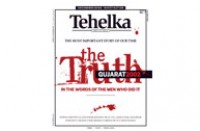Murder in Manipur

Manipur is both ignored by the news machine and indifferent to it. But the latest expose of a police killing there has led to a snowballing political crisis in the state. After a Tehelka report, women came out to protest in different parts of the state and the government imposed a curfew. Chief Minister Ibobo Singh who is seldom perturbed by the encounter deaths that take place under his watch called a press conference to announce a judicial inquiry and say that six police commandos and a sub inspector have been suspended.
Still photographs tell a story like nothing else can. They have the power to puncture indifference. The state of Manipur is a war zone which stays out of the national consciousness until a compelling photograph makes the news impossible to ignore. Back in 2004 it was the protest of Manipuri women carrying a banner, Indian Army Rape Us. They stripped naked, protesting against the rape of 32-year-old Manorama, allegedly by the Assam Rifles. That image jolted the national consciousness.
Today, more than four years later, it is Tehelka¿s series of photographs of a former militant being shot by Manipur commandos, completely without provocation. It forces a nation to sit up and take notice. The Commandos are police not army. They do not have immunity under the Armed Forces Special Powers Act.
Teresa¿s Rehman¿s story ¿Murder In Plain Sight¿ is written around an unnamed photographer¿s sequence of 12 shots which chronicle a straight killing. To call it an encounter as the police did would be fanciful. The story begins:
If any picture can speak a thousand words, these photos — available exclusively to TEHELKA — could fill volumes. They capture a shootout that happened in the heart of Imphal, Manipur¿s capital, barely 500 metres from the state assembly, on July 23. They show the moments before, during and after the ¿encounter killing¿ of a 27-year-old Indian citizen – a young man called Chongkham Sanjit, shot dead by a heavily-armed detachment from Manipur¿s Rapid Action Police Force, commonly known as the Manipur Police Commandos (MPC).
The government said this young man had been killed in an encounter. Several photographers were present because the incident followed a death just a short while before in which a pregnant woman died in collateral fire. No pictures were published, and no reports except one in the Manipur press called the killing a fake encounter. That was in the regional language paper Ireibak. Manipur journalists have to fear for their lives in the current atmosphere in the state. Then Rehman, who lives outside the state, got the pictures. The Manipur press, print and web-based, picked it up, and the pictures flew across the world.
To understand why the story in Tehelka is vitally important you just have to consider the figure that emerged from a recent monitoring The Hoot did of insurgency-related news in Manipur. Over a period of 60 days from May to July, the state recorded 37 encounter deaths, as culled from news reports in Manipur. That is more than one every two days. If that were to happen in
During this period the Times of India did not carry a single story with an Imphal dateline, not one of the encounter killings figured. The Hindu had 10 stories with Imphal datelines, two of them about militants killed. The Indian Express had one story which said "Militant killed in encounter in Imphal", and 8 stories with an Imphal dateline.
The Telegraph had, over this period (15 May to 15 July), three stories on Manipur, none on any encounter killings. DNA Mumbai had no stories on Manipur at all. Does the government at the Centre pay attention when the media blackout is so near complete?
Most of the Manipuris who wrote in to Teresa Rehman after the photographs and the story were published, all harped on the same thing. They hoped the pictures and story would open the eyes of the government in